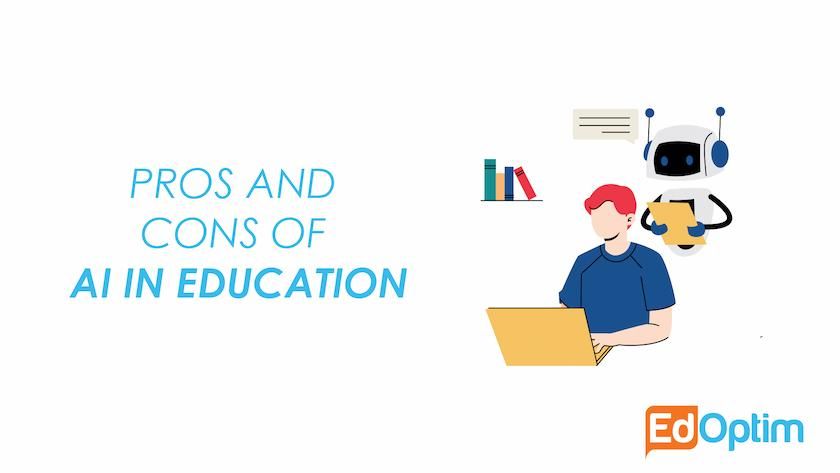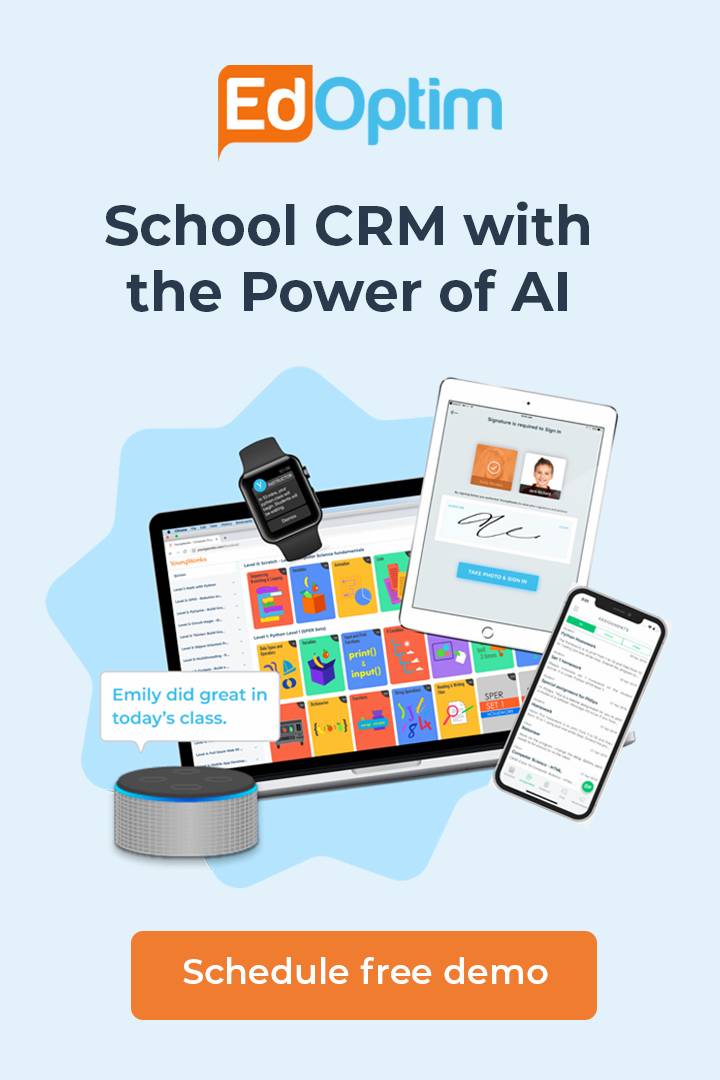Dec 15, 2024 By Team EdOptim *
What Is the Use of AI in the Education System?
Artificial Intelligence (AI) is being integrated into various aspects of education, bringing significant advancements in how teachers teach and students learn. Here's a deeper look at its diverse applications and impact:
1. Adaptive Learning
AI-powered systems customize learning experiences to align with the individual needs, preferences, and pace of each student.
Platforms like DreamBox Learning and Knewton analyze student interactions to adjust the difficulty of problems in real time.These tools help identify learning gaps, ensuring students master concepts before moving forward.
AI adapts to both fast learners by offering advanced content and slow learners by reinforcing fundamentals.
2. Interactive Lesson Plans
AI tools assist teachers in designing dynamic and engaging lesson plans.
Tools like LessonLab generate interactive modules incorporating videos, animations, and quizzes tailored to the curriculum.Teachers can modify AI-suggested plans to suit classroom environments, ensuring relevance and creativity.
These plans make complex topics, such as explaining chemical reactions or historical events, easier to understand through visual and interactive elements.
3. Automated Administrative Tasks
AI takes over repetitive and time-consuming tasks, enabling educators to focus on teaching and mentoring.
Grading tools like Gradescope can grade assignments, quizzes, and even essays using AI algorithms, ensuring consistency and saving time.
Attendance Tracking like AI-powered facial recognition systems, like those implemented in some schools in China, automate attendance, eliminating manual roll calls.
AI assists in creating conflict-free timetables, especially in educational institutions with multiple departments and complex schedules.
4. Data Analysis for Improved Outcomes
AI analyzes vast amounts of student data to provide actionable insights that enhance learning outcomes.
Platforms like Edmentum evaluate test results, participation metrics, and engagement levels to identify at-risk students.
Teachers can use this data to implement targeted interventions, such as one-on-one tutoring or additional resources for struggling learners.
Schools can track overall performance trends, helping administrators refine teaching methods and curricula.
5. Enhanced Learning Platforms
AI-powered platforms create engaging learning experiences using advanced technologies.
Simulations like Virtual labs, like Labster, allow students to conduct experiments in a safe, virtual environment, fostering a practical understanding of subjects like biology and chemistry.
Platforms such as Duolingo use gamified learning to make acquiring new languages enjoyable and interactive.
AI systems integrate videos, augmented reality, and 3D animations to explain abstract concepts, such as space exploration or molecular biology.
6. Intelligent Tutoring Systems (ITS)
AI-driven tutors provide personalized assistance to students outside the classroom.
Tools like Carnegie Learning's MATHia offer step-by-step guidance for solving math problems, simulating one-on-one tutoring.
These systems are available 24/7, helping students overcome learning obstacles at their convenience.
7. Language Learning and Translation Tools
AI makes learning new languages and breaking language barriers more accessible.
Apps like Google Translate and Babbel use AI to provide real-time translations and adaptive lessons for language learners.
AI-powered transcription tools help international students take notes in their native languages, ensuring they don’t miss critical information.
8. Assistive Technologies for Students with Disabilities
AI enhances accessibility, ensuring inclusive education for all learners.
Text-to-speech software, such as Kurzweil 3000, helps visually impaired students by reading aloud texts.
Speech-to-text tools enable students with hearing impairments to follow classroom discussions.
AI applications can also create custom content for students with learning disabilities, such as dyslexia, by simplifying texts and offering alternative explanations.
9. Virtual Reality (VR) and Augmented Reality (AR) in Learning
AI complements VR and AR to create immersive educational experiences.
AR apps like Google Expeditions allow students to explore historical landmarks or dive into the human anatomy without leaving the classroom.
AI tracks student interaction within these simulations, providing insights into their learning progress.
10. Career Guidance and Counseling
AI assists students in identifying career paths based on their strengths, interests, and academic performance.
Tools like CareerVillage use AI to provide personalized career advice and connect students with industry professionals.
AI-powered platforms guide students in selecting courses, internships, and extracurricular activities aligned with their goals.
11. Content Creation and Customization
AI tools help educators create customized content for different learning groups.
Platforms like ScribeSense assist in generating quizzes and assignments tailored to specific student needs.
AI can also reformat existing content, such as summarizing lengthy articles for easier comprehension.
12. Early Dropout Prediction and Prevention
AI systems monitor student performance and engagement to predict the likelihood of dropouts.
Schools and universities can intervene early by offering support systems like mentorship programs or academic counseling.
This proactive approach improves retention rates and ensures students stay on track.
13. Lifelong Learning and Upskilling
AI supports adult education and professional development.
Platforms like Coursera and LinkedIn Learning use AI to recommend courses and provide skill-based certifications.
Personalized learning paths help professionals stay updated in rapidly evolving industries like technology and healthcare.
Pros of AI in Education
1. Enhanced Personalization
AI technologies revolutionize personalization by adapting to individual students' learning styles, preferences, and progress.
Platforms like adaptive learning systems analyze student performance using machine learning to identify gaps and recommend tailored educational content.
For example, students struggling with mathematical concepts can receive additional practice materials, while advanced learners explore higher-level problems.This targeted approach improves comprehension, retention, and overall academic performance.
2. Improved Accessibility
AI-powered tools make education inclusive and accessible, catering to the unique needs of diverse learners.
Text-to-speech and speech-to-text technologies assist students with visual and auditory impairments.
Translation tools bridge language gaps for international students, enabling them to thrive in multilingual environments.
AI platforms adapt content for students with disabilities, such as dyslexia, by simplifying language or providing alternative explanations.
3. Streamlined Administrative Processes
AI simplifies time-consuming administrative tasks, allowing educators to focus on teaching.
Grading essays and quizzes is automated, saving hours of manual work.
Attendance tracking and scheduling are handled by AI systems, minimizing human error and ensuring efficiency.
These advancements create a more productive learning environment by freeing teachers from repetitive tasks.
4. Real-Time Feedback and Instant Support
AI provides immediate feedback on quizzes and assignments, enabling students to correct errors and strengthen their understanding promptly.
Chatbots powered by natural language processing act as virtual tutors, offering 24/7 academic support.
This instant feedback mechanism fosters continuous improvement and builds student confidence.
5. Strengthened Problem-Solving Skills
AI tools, such as gamified learning platforms and simulations, promote critical thinking and problem-solving through interactive challenges.
Students develop analytical skills by navigating AI-driven scenarios, such as solving real-world physics problems in a virtual lab.
These tools prepare students for dynamic, real-world challenges while keeping them engaged.
6. Scalability
AI enables institutions to efficiently handle large-scale educational operations, delivering quality content to thousands of students.
Example: Massive Open Online Courses (MOOCs) like Coursera use AI to provide personalized learning paths to diverse learners across the globe.
This scalability ensures high-quality education for students, regardless of geographic or financial limitations.
7. Enhanced Educational Content Creation
AI assists educators in developing innovative and engaging lesson plans.
By analyzing curriculum needs, AI tools generate multimedia-rich content that appeals to different learning styles.
Teachers can integrate gamified content, real-world simulations, and interactive exercises to make lessons more impactful.
8. Ethical Insights for Student Development
AI can identify patterns in student behavior that might signal emotional or academic struggles, enabling timely intervention.
For example, AI tools can detect signs of disengagement or stress based on performance data and offer solutions like counseling resources.
Cons of AI in Education
1. Privacy and Ethical Concerns
AI relies on access to sensitive student data, raising concerns about data privacy and ethical considerations:
Institutions must address how data is stored, who can access it, and what safeguards are in place.
A breach could expose student records, undermining trust in AI systems.
2. Over-Reliance on Technology
Excessive dependence on AI may reduce traditional learning skills:
Students risk losing independent problem-solving abilities by relying on automated systems.
Educators must balance AI integration with activities that promote creativity and human interaction.
3. Lack of Human Interaction
AI tools, while efficient, cannot replicate the empathy and mentorship provided by human teachers:
Social and emotional development often depends on personal interactions, such as group discussions and collaborative projects.
Over-reliance on AI may create a sterile educational experience, reducing opportunities for peer learning.
4. Algorithmic Bias
AI algorithms can inadvertently reflect biases in their training data, leading to unfair outcomes:
Biased algorithms may favor certain demographics, affecting assessments, admissions, or access to resources.
For instance, a flawed system might rate essays differently based on linguistic styles associated with specific cultural backgrounds.
5. High Implementation Costs
The deployment of AI solutions often requires significant investments, straining the budgets of underfunded institutions:
Initial setup costs for AI tools, training, and infrastructure can be prohibitive.
This economic barrier may widen the gap between well-funded and struggling schools.
6. Encouragement of Misuse
AI tools like ChatGPT may unintentionally promote academic dishonesty:
Students can misuse AI to generate essays or solve assignments without understanding the material.
Educators must establish strict guidelines to ensure AI is used for learning rather than shortcuts.
7. Potential Drawbacks in Creativity
By relying on AI-generated content, students may struggle to develop original ideas:
Overuse of tools that assist with writing or problem-solving might hinder the natural development of creative and critical thinking skills.
8. Learning Inequalities
Not all students or schools have access to AI technologies, exacerbating educational disparities:
While urban schools may benefit from AI integration, rural institutions with limited resources might fall further behind.
FAQs
1. What Are the Advantages and Disadvantages of AI in Education?
Advantages: Personalization, improved engagement, and automation.
Disadvantages: Privacy concerns, lack of human interaction, and high costs.
2. How Does AI Impact Teachers and Students?
Teachers: AI supports routine tasks and provides insights into student performance.
Students: AI offers 24/7 access to resources but may hinder independent thinking if overused.
3. Is ChatGPT Helping or Hindering Learning Outcomes?
Helping: Simplifies complex topics and supports independent learning.
Hindering: Risks over-reliance and superficial understanding.
The Future of AI in Education
AI will continue to transform education by:
- Introducing AI-driven innovations for personalized learning.
- Supporting collaboration between educators and AI systems.
- Nurturing skills like critical thinking and creativity that AI cannot replace.
Conclusion
The integration of AI into education is reshaping the learning process, offering numerous potential benefits of AI such as personalization, accessibility, and streamlined operations. It supports student learning by fostering effective learning through adaptive technologies and interactive platforms, especially in fields like computer science, where AI tools can simplify complex concepts and provide hands-on simulations.
However, this advancement must be approached cautiously. Over-reliance on AI may diminish the essential human touch, which remains vital for addressing emotional and social needs, building creativity, and nurturing critical thinking. Furthermore, challenges such as inequities in access, risks of plagiarism, and ethical concerns surrounding data privacy and bias need careful mitigation to ensure fairness and inclusivity.
To maximize student progress and harness the full potential of AI, educators must balance technology with traditional teaching methods, emphasizing the irreplaceable value of human interaction. By doing so, we can create a more dynamic, inclusive, and forward-looking education system that empowers learners for the future.
*Contributors: Written by Prasanna MG; Edited by Riya Kumari Singh; Lead image by Shivendra Singh

